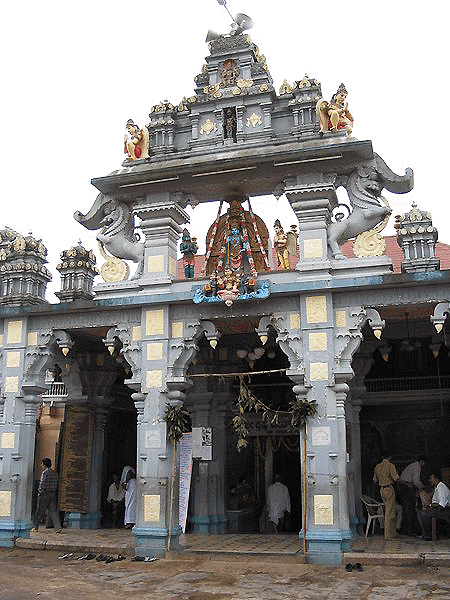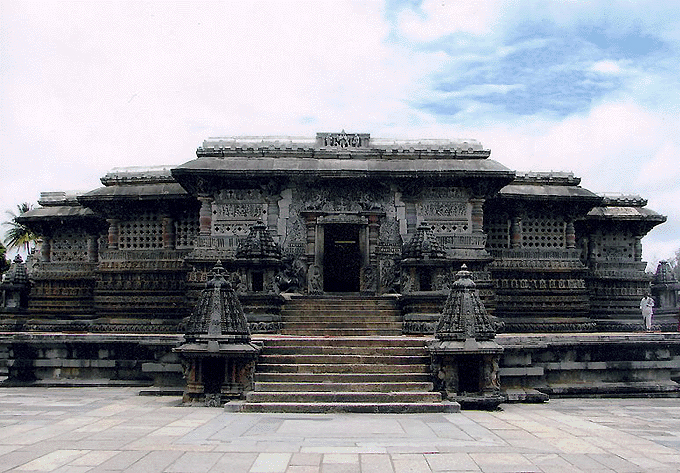
|
|
|
|
BY: SUN STAFF

Udupi Gopala Krsna deity in jeweled vesha Feb 09, CANADA (SUN) — A serial exploration of the holy sites visited by Lord Caitanya. Tritakupa
In Sri Caitanya-caritamrta Madhya Lila 9, the summary of Lord Caitanya's travels describes various tirthas He visited in the area around Udupi, Karnataka:
Madhya 9 Summary:
"At the village of Udupi He saw the Gopala Deity installed by Sri Madhvacarya. He then defeated the Tattvavadis in sastric conversation. The Lord next visited Phalgu-tirtha, Tritakupa, Pancapsara, Surparaka and Kolapura." In Sri Caitanya-caritamrta Madhya Lila 9, the summary of Lord Caitanya's travels describes various tirthas He visited in the area around Udupi, Karnataka:
Madhya 9 Summary: "At the village of Udupi He saw the Gopala Deity installed by Sri Madhvacarya. He then defeated the Tattvavadis in sastric conversation. The Lord next visited Phalgu-tirtha, Tritakupa, Pancapsara, Surparaka and Kolapura."
In Madhya lila 9.279, we get a further description of the Lord's visit to Tritakupa tirtha:
Madhya 9.279
"Sri Caitanya Mahaprabhu, the son of mother Saci, next went to Tritakupa, and after seeing the Visala Deity there, He went to the holy place known as Pancapsara-tirtha."
Although Srimad Bhagavatam 3.1.22 mentions a pilgrimage site called Trita on the bank of the River Sarasvati (tritasya), the now unseen, ancient river in northwest India, the Trita-kupa referred to in Madhya 9 is south, in Karnataka.
While little information on Tritakupa, Karnataka is available in Caitanya-caritamrta or the Bhagavatam, some details are provided in historical accounts of Caitanya Mahaprabhu's life.
In Chaitanya's Pilgrimages and Teachings by Jadunath Sarkar (Calcutta 1913), a biography contemporary to Caitanya-caritamrta Madhya lila, the author writes that after Mahaprabhu had defeated the high priest of the Tattwa School (at Udupi), he traveled on to the Falgu (Phalgu) shrine, then to Tritakupa, the shrine of Bishala (Vishala).
Elsewhere we find reference to the Falgu pilgrimage site as being at Tritakupa, Belur. Belur (Bellur) is located about 350 km southeast of Udupi, in Karnataka. At Belur, Lord Caitanya is said to have visited the Channakeshab (Channakeshava) temple, and other temples where He was overwhelmed by the beautiful temple art.
The list of place names provided in Madhya lila 9 -- Phalgu-tirtha, Tritakupa, Pancapsara, Surparaka and Kolapura – serves as an interesting example of how the various tirthas visited along a pilgrimage route may not at all be in the order they were visited. For example, Tritakupa is in Karnataka, but Lord Caitanya's visit to Surparaka (Sopara) was far north, in Maharashtra state.
This phenomenon is further illustrated when we look at the references to Lord Balarama and Nityananda Prabhu's travels, apparently to the same Tritakupa Sri Caitanya visited. In Srimad-Bhagavatam 10.78.19-20 we read about Balarama's travels:
SB 10.78.19-20
SYNONYMS TRANSLATION In Krsna Book, Chapter 78, Srila Prabhupada also mentions Lord Balarama's travels to these places, as follows:
"After this, accompanied by some respectable brahmanas, He decided to visit different places on the bank of the river Sarasvati. He gradually visited such places as Prthudaka, Bindusara, Tritakupa, Sudarsana-tirtha, Visala-tirtha, Brahma-tirtha and Cakra-tirtha. Besides these, He also visited all the holy places on the bank of the Sarasvati River running toward the east. After this He visited all the principal holy places on the bank of the Yamuna and on the bank of the Ganges. Thus He gradually came to the holy place known as Naimisaranya." It's interesting to note that the Bhagavatam 10.78.19-20 sloka refers to: "trita-kupam sudarsanam -- the pilgrimage places known as Tritakupa and Sudarsana". This would seem to indicate that the two places are close together. Trita-kupam is also hyphenated, 'kupam' generally referring to 'well'.
Just as Madhya 9.279 states that Lord Caitanya visited the Visala Deity at Tritakupa, both Bhagavatam 10.78.19-20 and Krsna Book mention that Lord Balarama visited Tritakupa and Visala (Visala-tirtha). The other places mentioned with respect to Balarama's travels, however, appear to be far from Karnataka – most being in the north, in the region of the Saraswati.
Similarly, in his Nityananda Charitamrita, Srila Vrindavana Dasa Thakur describes Nityananda Prabhu's travels:
Adi-Khanda Chapter 2 "The Lord also visited Kurukshetra, Prithudaka, Bindu-sarovara, Prabhasa, and Sudarsana-tirtha. He then visited the exalted holy place called Trita-kupa. He also went to Visala, Brahma-tirtha, and Cakra-tirtha. The Lord visited Pratisrota where the Sarasvati River flows in the opposite direction. The most magnanimous Lord Nityananda then went to Naimisharanya."
To further illustrate the point about the great geographic difference between places listed in this way, here is an abbreviated version of some of the grouped tirthas mentioned above:
There seems to be no question that the Tritakupa listed here is located at Belur, Karnataka, and the shrine of Visala is there. And without question, the Saraswati River is in northwest India, from which it flows into the Yamuna and Ganges rivers at Prayag. All of the other locations appear to also be in the upper half of India.
So the great distances that sometimes exist between pilgrimage sites is particularly evident in the above clusters of tirthas. Srila Prabhupada has perhaps given us a clue in this regard in Krsna Book, Chapter 78, where he mentions that Lord Balarama "gradually visited" these places.

Udupi Krsna Temple Sri Caitanya's Visit at Udupi
As described in Madhya Lila, Lord Caitanya visited the Gopala Krsna Deity installed by Sri Madhvacarya at Udupi. This famous and most beautiful Deity (pictured above) was installed at Madhya's Krishna Mutt in the 13th century. The story of the Deity is very well known:
A businessman trading in gopi-candana owned a boat that became stuck in the mud near where Sri Madhvacarya was bathing in the ocean. In exchange for helping to move the boat, an extraordinary feat, the boat owner offered Madhva a large piece of candana as a gift. While unloading the chunk of candana from the boat, it broke, and the beautiful Deity of Sri Gopala manifested. The Deity, Whose name was Bala-gopala, or Dadhi-manthana Gopala, is so named because He carries Mother Yasoda's stick for churning yogurt.
Sri Madhva ecstatically carried the heavy deity home to Udupi, a walk of seven miles, singing and composing as he went the famous Dvadasa-stotra (Twelve Prayers) to the Lord.

Chennakesava Temple, Belur Sri Caitanya's Visit to Channakeshava Temple
Belur, Karnataka is home to the ancient Channakeshava (Channakeshab) temple, where Lord Caitanya is said to have enjoyed seeing the beautiful temple art. Known in ancient times as the Vijayanarayana Temple, Channakeshava was built in 1117 A.D. on the banks of the Yagachi River in Belur, an early capital of the Hoysala Empire.
'Chennakesava' literally means "handsome Kesava". The presiding deity there is Lord Visnu. King Vishnuvardhana provided funds for the construction of the temple. Having converted from Jainism to Vaishnavism, and having won many important battles, the King determined to make this offering to the Lord, Who came to visit the place in person nearly 400 years later, in the form of Sri Caitanya Mahaprabhu.
| |